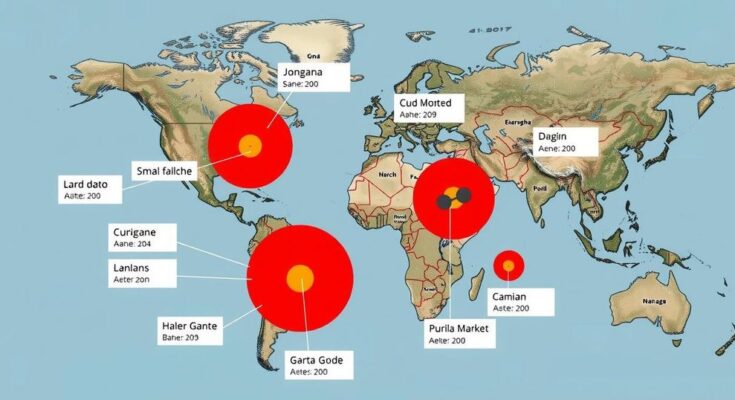This article discusses the five largest earthquakes in recorded history, emphasizing their catastrophic effects and the widespread devastation they caused. The earthquakes examined include the 1960 Chile quake, the 1964 Alaska earthquake, the 2004 Indian Ocean tsunami, the 2011 Japan quake, and the 1952 Russia quake, all of which underscore the destructive power of seismic events.
Earthquakes represent a significant geological phenomenon, known for their potential to cause extensive devastation. Among the most powerful recorded earthquakes in history, five events stand out prominently, showcasing their catastrophic impacts. On November 4, 1952, a 9.0 magnitude earthquake struck Severo-Kurilsk, Russia, causing over 10,000 casualties and a resultant tsunami. Japan faced a monumental 9.0 earthquake on March 11, 2011, leading to widespread destruction and the Fukushima disaster, with approximately 18,000 people impacted by the tremors and ensuing tsunamis.
The infamous Boxing Day Earthquake in 2004, measuring 9.1, was a harrowing event that unleashed devastating tsunamis across several countries, claiming over 230,000 lives. On March 27, 1964, the Good Friday earthquake in Alaska recorded a magnitude of 9.2, resulting in significant fatalities and extensive damage. The strongest earthquake to date, which occurred in Chile on May 22, 1960, fluctuated between magnitudes 9.4 to 9.6 and left approximately 1,655 fatalities, alongside displacing two million individuals. These events demonstrate the catastrophic potential of seismic activity, particularly within the ‘Ring of Fire’ region of the Pacific Ocean where the majority of severe earthquakes occur.
The topic of significant earthquakes in history underscores the monumental effects of seismic activity on human life and infrastructure. Earthquakes predominantly occur along the Pacific Ring of Fire, a tectonically active zone, resulting in frequent and dangerous tremors. This article examines five of the largest earthquakes ever recorded, highlighting their magnitudes, geographic locations, destruction, and human toll, thereby offering insights into the patterns of seismic activity and the challenges of post-disaster recovery.
In summary, the examination of the largest earthquakes in history reveals their devastating impacts on communities, infrastructure, and entire nations. The tragic events documented, from the Chile earthquake of 1960 to the Indian Ocean tsunami of 2004, underscore the importance of seismic monitoring, preparedness, and effective response strategies to mitigate the impact of future earthquakes. Global awareness and scientific advancements in earthquake prediction and disaster management are paramount in preventing loss of life and minimizing destruction in the wake of such natural disasters.
Original Source: www.standard.co.uk




